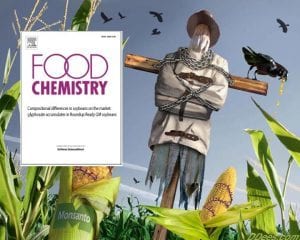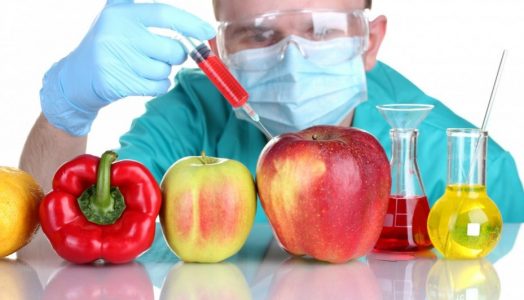GMOs, or “genetically modified organisms,” are plants or animals created through the gene splicing techniques of biotechnology (also called genetic engineering, or GE). This experimental technology merges DNA from different species, creating unstable combinations of plant, animal, bacterial and viral genes that cannot occur in nature or in traditional crossbreeding. This creates combinations of plant, animal, bacteria, and virus genes that do not occur in nature or through traditional crossbreeding methods. Most GMOs have been engineered to withstand the direct application of herbicide and/or to produce an insecticide. However, new technologies are now being used to artificially develop other traits in plants, such as a resistance to browning in apples, and to create new organisms using synthetic biology. Despite biotech industry promises, there is no evidence that any of the GMOs currently on the market offer increased yield, drought tolerance, enhanced nutrition, or any other consumer benefit. Meanwhile, a growing body of evidence connects GMOs with health problems, environmental damage and violation of farmers’ and consumers’ rights.
Most developed nations do not consider GMOs to be safe. In 61 countries around the world, including Australia, Japan, and all of the countries in the European Union, there are significant restrictions or outright bans on the production and sale of GMOs. In the U.S., the government has approved GMOs based on studies conducted by the same corporations that created them and profit from their sale. Increasingly, Americans are taking matters into their own hands and choosing to opt out of the GMO experiment.
Myth: GMOs Are Just an Extension of Natural Breeding Techniques
Many GMO proponents claim that genetic engineering is just an extension of natural breeding methods, and just as safe. Nothing could be further from the truth — on both counts.
Genetic engineering is radically different from conventional breeding techniques used to improve a crop. For starters, it’s a laboratory-based technique allowing scientists to create a food that could never be created by nature. As explained by Robinson:
“Genetic engineering enables DNA to be transferred not only between different kinds of plants, but even between different kingdoms. You can take DNA from an insect, an animal, a virus or a bacterium, and insert it into the genome of a food crop plant.
This is actually a very imprecise process. The truth is that the genetic engineering process disrupts the genome (organization and function of genes) of the plant. As a result we found time and time again that there are unexpected effects on the plant that is genetically engineered.
They tell us that it’s exactly the same, except for the inserted gene that’s been deliberately put in…But this isn’t the case. The genome is very complex. It’s not like Lego; you can’t just take out one bit, put in another bit, and expect there to be no knock-on effects.”
Unintended and Unforeseeable Side Effects Abound
There have been many occasions where the GE crop has been unexpectedly toxic or allergenic when the non-GE crop had no such issues. The reality is that scientists really don’t know what they’re doing in terms of what side effects are produced by DNA tampering. The effects are very unpredictable.
Genetic engineers are just now starting to admit this. Ironically, many of the drawbacks of genetic engineering, including the fact that it’s imprecise, were not openly admitted until they came out with a new technique, called genome editing and using, for example, CRISPR technology, which is said to be far more precise than earlier methods.
Alas, even genome editing techniques such as CRISPR create off-target effects, according to Robinson. So we’re still far from knowing all there is to know about genetic manipulation.
Why CRISPR Technology Will Not Remove Concerns
While the use of CRISPR-cas 9 allows more precise genetic engineering in one respect, in that you can target a genetic alteration including foreign gene insertion to a specific area of the genome, the potential for unintended effects remain, for the simple fact that when you alter one or two genes in a genome the side effects ripple through the whole genome.
In addition, just as with conventional genetic engineering, genome editing involves using plant tissue culture (plant cells grown under laboratory conditions), which has a wide-scale DNA mutagenic (damaging) effect in its own right. This too can dramatically alter the function of multiple gene functions.
Thus the off-target effects of genome editing and plant tissue culture-induced mutations can combine to bring about alterations in plant biochemistry.
One or more new proteins could be created in the process, which could be toxic or allergenic, or you could change the biochemical pathways of a plant, making it less nutritious or more toxic.
“In addition, most genetically engineered plants are engineered to either express an insecticide or to tolerate being sprayed on by an herbicide (weedkiller).
That means you’ve got the potential toxic effects of the herbicide residues that are sprayed on the plant or of the insecticide that is engineered into the plant,” Robinson notes.
The risk of unintended consequences is so high that even if scientists restricted the genetic engineering to the alteration of just one or two host plant genes or the insertion of genes into a plant into the very same species, say from corn to corn, these problems still would not disappear. As Robinson explains:
“The important thing when you’re genetically engineering a plant is the new context of the gene that you’re putting in. Even if you were to take a gene out of apples and put it into apples, you don’t really know what that’s doing, because all of a sudden the gene is in a new context.”
GMO Creation Is a Cruel and Wasteful Enterprise
Genetic engineering is also a very wasteful process. You create an enormous number of plants that are deformed, infertile, or otherwise not viable, so there’s a lot of waste. When it comes to the creation of GE animals there’s also the moral aspect of creating so many non-viable life forms.
“One of the scientists who I’m in contact with happened to see some GE salmon that were created in the research and development phase. He said it was really shocking, because there were salmon that were green in color. There were salmon that had lumps all over their bodies. All these had to be thrown away… I think it’s a very cruel process, because you’re creating so many non-viable animals, and you have to dispose of them.”
Long-Term Safety Studies Are Sorely Lacking
 “GMOs are proven safe,” is the oft-repeated refrain. But where is the actual evidence for this? And what’s the strength of that evidence? While few in number, longer-term animal feeding studies have been published over the past several years showing there’s definite cause for concern. Liver and kidney toxicity and immune reactions tend to be the most prevalent. Digestive system, inflammation and fertility problems have also been seen.
“GMOs are proven safe,” is the oft-repeated refrain. But where is the actual evidence for this? And what’s the strength of that evidence? While few in number, longer-term animal feeding studies have been published over the past several years showing there’s definite cause for concern. Liver and kidney toxicity and immune reactions tend to be the most prevalent. Digestive system, inflammation and fertility problems have also been seen.
“I think we’re all concerned about the state of people’s immune systems these days. Obviously it is a huge concern. I think any substance you feed to a laboratory animal and get an immune response [from], you really have to ask more questions about it,” Robinson says.
A major part of the problem is that safety studies conducted for regulatory purposes to gain market approval for a GE product are too short to show the damage that could occur from life-long consumption of the GE food. Some independent studies looking at lifetime consumption of GMOs have found rather dramatic health effects, whereas the safety studies used to promote GE foods as safe have all been short-term.
As noted by Robinson, there seems to be an agreement among biotech scientists to not test GE foods longer than 90 days in rats, which is only about seven to nine years in human terms. That’s nothing when you consider the average lifespan is somewhere in the 70’s, and the current generation is fed GMO food from day one.
“Typically, even in industry tests for 90 days in a rat, you can see signs of liver and kidney toxicity, and immune responses… What happens is they just dismiss the findings. They say, ‘These are not biologically relevant findings. We don’t need to do longer testing.’ This is a really an unscientific, worrying phenomenon. We should be doing long-term testing and multigenerational testing as well with all GE foods to get to the bottom of what is going on.”
Making matters worse, carefully calculated barriers have been erected by the GE industry to prevent independent researchers from ever doing those kinds of studies in the first place. Anyone purchasing GE seeds must sign a contract that forbids them from supplying them to researchers who do research, and in most cases the companies refuse to provide seeds to independent researchers.
Myth: Hundreds of Millions of GMO Meals Served With No Adverse Effects
Another completely unscientific and dishonest claim used to justify the use of GMOs is that Americans have eaten hundreds of millions of GMO meals with no ill effects. But who’s actually checking? No one is assessing and keeping tabs of potential side effects. You can’t even make that connection since GE foods are not labeled.
Despite that lack of traceability, health statistics clearly show Americans have been getting increasingly sicker over the past few decades. Chronic diseases are definitely increasing, and children are increasingly coming down with diseases that in the past did not arise until much later in life. No one can say for sure that there’s a link to GMO consumption since they’re not labeled and therefore cannot be tracked, but you certainly cannot ignore the possibility of a link either.
In November 2012, the Journal of Food and Chemical Toxicology published a paper titled Long Term Toxicity of Roundup Herbicide and a Roundup-Tolerant genetically modified maize by Gilles-Eric Seralini and his team of researchers at France’s Caen University. It was a very significant study that made a lot of noise worldwide, the first of its kind under controlled conditions that examined the possible effects of a GMO maize diet treated with Monsanto’s Roundup Herbicide.
After the research was completed, it went through rigorous reviews, as well as a four month review process by scientists and researchers. It was eventually approved and published, only to be retracted by request of the Journal. Although hundreds of scientists around the world condemned the retraction, and the researchers addressed the criticisms, it was to no avail.
This major GMO study has now been republished following its controversial retraction (under strong commercial pressure), with even more up to date information and a response to previous criticisms. “We also show that the decision to retract cannot be rationalized on any discernible scientific or ethical grounds. Censorship of research into health risks undermines the value and the credibility of science, thus, we republish our paper.” – Seralini
Myth: Without GE Crops We Cannot Feed the World
Another common claim is that we need GMOs because without them we don’t stand a chance to feed our growing population. This is nothing but a flawed fantasy, and there are at least half a dozen truths that dispel it.
Part of the myth is that GE crops provide greater yield, but they don’t. There is no gene for high yield. The GMO genes inserted are for creating herbicide tolerance or to produce internal insecticide. There is no way of genetically engineering high yield into a crop as it is dependent on complex multi-gene interactions, which GE cannot deliver.
However, conventional breeding methods are helpful for increasing yield as they can introduce the required multi-gene families into the crop. So a high-yielding GE crop is simply a crop that has been conventionally bred to produce high yields. Then the genetic engineers inserted an herbicide-tolerant gene or an insect-resistant gene into that plant.
The U.S. Department of Agriculture (USDA) even admits that yield is dependent on the background genetics of the crop; it is not dependent on the genetic engineering. In some cases the GE crop ends up yielding less than its non-GE equivalent.
That is certainly the case with GE soy, where there is what is known as a yield drag. It yields less than the non-GM soy. Exactly why is still unknown, but Robinson suggests it may be caused by the disruptive effect of the GE transformation process, or perhaps the GE plant’s energy is somehow used up in resisting herbicide, for example, and therefore has less energy left over for growth.
Soil Destruction Promotes Food Scarcity
GE plants — courtesy of the herbicides used — also destroy the microbial health of the soil. Ultimately, you need the microbes in the soil to nourish the plant, and it’s this symbiotic relationship that provides good yields.
From a long-term strategic perspective, destruction of topsoil is the greatest threat to the future of food, and if we continue in this way, people will starve no matter what GE plants they come up with. It’s a prescription for disaster. Once you implement regenerative agriculture you almost automatically create far greater yields, as these time-honored traditions nourish and build soil health.
“There’s some very good long-term research done at the Rodale Institute which shows that year upon year, the yields with organic systems can go up and up and up, because the soil fertility and health, including microbial life, is being built. Also, organics yield better in drought conditions, because there’s more organic matter in the soil, which acts like a sponge and it can hold water.
If we’re thinking about resilient agriculture that’s going to tide us through climate change and everything else the future can throw at us, it’s really all about agroecology, organic, and building soil. We certainly don’t want to be killing soil by putting glyphosate or other pesticides on it.
We do know that putting glyphosate herbicide on the soil actually ties up trace metal nutrients within the soil. It makes them less available to the plant and less available to us when we eat those plants,” Robinson says.
The World Health Organization’s International Agency for Research on Cancer (IARC) has also classified glyphosate as a probable carcinogen. Over 80 percent of GE plants are engineered to tolerate being heavily doused with glyphosate-based herbicides such as Roundup.
Worryingly, laboratory tests have shown that commercial formulations such as Roundup, which are complex mixtures of chemicals, are up to 1,000 times more toxic than glyphosate in isolation. Roundup gets incorporated into the entire plant and cannot be washed off, so when you eat those plants, you’re eating a general toxin and potential carcinogen.
Continued on next page…




